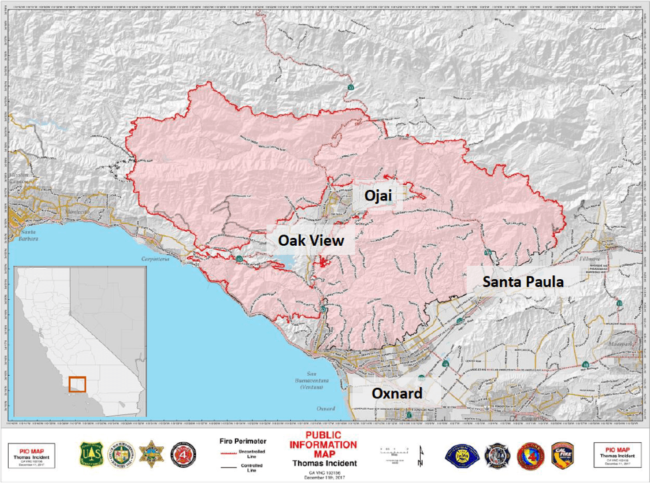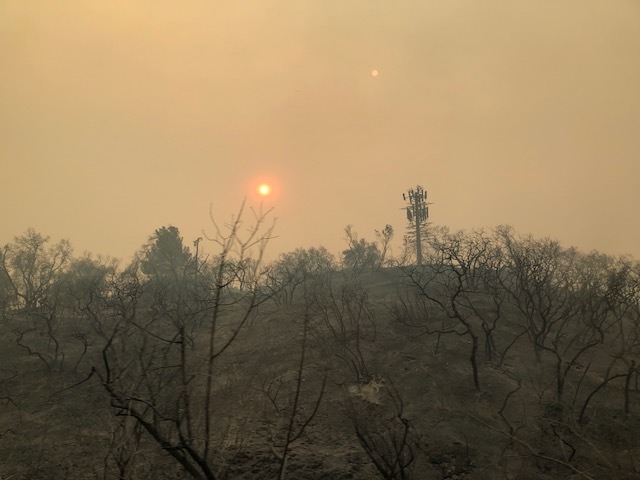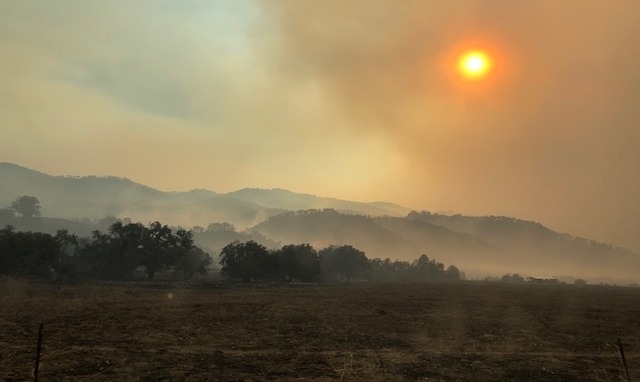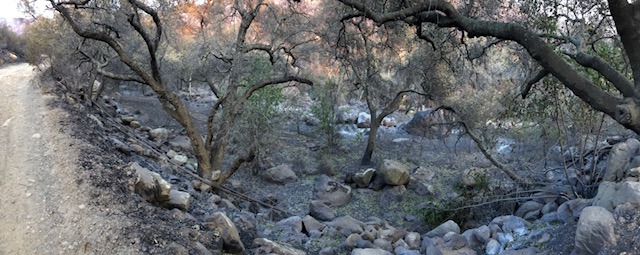I am an ecologist and conservation biologist. My work with conservation challenges in California and across western North America have rooted my perspective in natural history and science. In early December 2017, my home, family, and places I love were threatened by wildfire, making the natural and unnatural changes in this landscape a whole lot more personal.
At 8:45 pm on Monday December 4, I was packing up to leave a meeting in downtown Ojai, California when I noticed my phone screen was lit up with several texts.
From my husband, 7:36 pm:
“Have a fire near Santa Paula. Sky looks scary but all good right now. Monitoring the live Fire Dept feed.”
From a friend, 8:18 pm:
“Offering my place to you guys in Oak View if you need it. I have a dog door and big fenced yard”
Husband again, 8:36 pm:
“Second fire near Koeningstein road. Too close for me so I grabbed a few things best I could and we are headed down to you”
And it was on. I had been nervous about wildfires all during Ojai’s hot, crispy summer, then as winter approached—even though it hadn’t rained—I mostly forgot about it. I just don’t think of December as fire season. At least I didn’t. Even as I waited for my husband and dogs to join me on what would become our evacuation odyssey, I wasn’t that anxious. Shock, maybe, but it just didn’t seem real. We stayed at a friend’s house in Oak View that night while she received reports that the just-built facility of the nonprofit she works for was burning to the ground.

By early the next morning, it was time to evacuate Oak View too. The fire had burned its way west across Sulphur Mountain and was engulfing houses in the Ventura foothills, heading our way. A friend in Oxnard reached out to see if we were okay, and offered us her place to stay. We packed up the dogs and headed west on highway 150 toward the 101, which we could take south to Oxnard. Turning the corner to 101 southbound in Carpinteria, the smoke was a streak of red out to sea as the sun rose ominously behind it. A bird flew directly into the grill of my truck.
The drive to Oxnard was long, each mile crawling beneath the truck tires. Traffic was not congested, but all of the cars in both directions had slowed, exhibiting an unusual caution, signaling collective shock and disbelief. I wanted to drive faster but couldn’t, with a sense that excess speed would send this already-surreal situation spiraling out of control.
Despite my struggle to absorb and comprehend the reality of what was happening, there really was nothing unbelievable about this extremely hot, fast-moving wildfire. Rare? Yes, so far. Unbelievable? No. Southern California’s Mediterranean climate is defined by hot, dry summers and cool, wet winters—and an occasional fire. What is so unusual about this fire season is that it extended into winter due to a perfect storm: a wet winter last year that encouraged the growth of vegetation, an extremely dry summer and fall that cooked that vegetation into tinder, and ruthless Santa Ana winds—also at an unusual time of year—that fanned the fire for days on end. This combination is decidedly not normal. And yes, you guessed it—we are pretty much to blame. We are responsible for suburban sprawl and poor planning, a long history of fire suppression, and climate change.
In fact, climate change is predicted to make the conditions that created the Thomas Fire worse—for example, we are likely to see more year-round fire seasons from now on. In 2006, research predicted that Santa Ana wind events would shift to later in the year, from early fall to late fall and early winter. This is exactly what happened during the Thomas Fire. 2017 was the worst fire year on record in California, and the Thomas Fire is the largest in the state’s recorded history. Given the accelerated frequency of these anomalies, these records will likely not hold long.
We were displaced by evacuation orders for nine days, and watched on the news from our friend’s living room, as—day after day after day—the Thomas Fire continued to burn. Across Ojai, across the wilderness—so many beautiful places where I explored, wandered, and did the fieldwork for my dissertation research.

We checked the fire perimeter map regularly. I felt nauseous as I watched the polygon engulf our neighborhood. A second fire had started at about 7pm on the night that the Thomas Fire started, just two blocks east of our house, upwind of the Santa Anas. This fire tore through our neighborhood that night and eventually joined the Thomas Fire.

Two days in, we received word from a neighbor that residents of our small rural community were being allowed past the police barricade, with ID, to assess the damage to their homes. Anxious to find out if we still had a house, we made our way into Ojai, under a heavy snowfall of ash. The air ached in our lungs, even with the poorly placating masks we wore on our faces. Continuing strong winds toppled power poles that had been burned to thin twigs, draping power lines over the road and forcing us to wait for hours.
When we finally got through, part of me wanted to turn back around. The mountain I had driven up and down hundreds of times was unrecognizable; nothing was left but ash and blackened sticks where shrubs used to be. Above, in the small valley where we live, it was more intermittent—one house burned to the ground, then two or three left completely unscathed. As we rounded the last corner on our road before our house, my heart and gut gripped each other, anxious for what we would find.
Despite the fire burning six houses on our street, our house was there, intact. We put out a smoldering pile of debris on our neighbor’s property with the trickle water pressure we had: the water tanks that serve our neighborhood from our communal well had been drained to battle the fire. With no food or cover left nearby, huge flocks of birds were taking refuge in our yard—yellow-rumped warblers, hermit thrushes—more birds than I had ever seen there at any time of year. In our absence, someone had opened our chicken coop to give our two chickens a fighting chance when the fire came. We found them waiting on our deck, peering into the windows for us. The giant 200-year-old oak tree in our yard even made it through untouched, as it must have for many fires now, at least three in the last 40 years.

After nine days, the evacuation orders for our area were lifted. For weeks, the smell of smoke permeated our days. Our area had a bonus hazard—oil seeps that were ignited when the fire came through and resisted being put out. Some mornings the air reeked of burning hydrocarbons. It was bizarre to have to feel safer indoors when normally outside is where I feel most myself.
Once the evacuation orders were lifted, we took our first walk into the wildlands adjacent to our house because I was curious to see what the fire had done there—I had seen burn scars but never a freshly burned landscape in this kind of habitat. The trail runs along a creek and up a canyon, dotted with oaks and sycamores that provide their sweet, shady canopy cover. This was part of the reason I wanted to live here—I grew up with northern hardwood forests in the Upper Midwest, so having tree branches overhead feels more like home. I was expecting to see a disaster and feel heartbreak as I witnessed my favorite daily hiking spot reduced to ashes.
There were lots of ashes where the underbrush had once been. There were smoldering stumps of old oak trees that had suffered heart rot. There was also an open gallery forest—the removal of the underbrush revealed the creek terraces, open and wide and inviting. The water in the creek ran clear. The strong, healthy oak trees were alive and intact, with just some charring on the outer layers of their bark, and even then only in small patches. Migratory yellow-rumped warblers and white-crowned sparrows flitted between pools in the creek. Scrub jays pounced up in the branches. The fire, at least in this spot, had burned in a patchy mosaic—some areas had been burned hard, and others—including a holly leaf cherry—were green and entirely intact.

Rather than mourning the loss of this place as I’d always known it, I wanted to wander the freshly open terraces for the rest of the day and explore. In the wild lands, the fire did not feel like a disaster—it felt more like a change of clothes.
At the same time, hidden beneath the new landscape is that which cannot be seen because it is now missing. In megafires like this, wildlife lose their lives and habitats more than we can even measure. Wildlife that does manage to escape has nowhere else to go, having lost all of its habitat. Driving the roads in our area since the fire, I’ve noticed a huge reduction in roadkill: the animals—particularly the mammals—just aren’t there to get hit anymore. This exemplifies just how devastating these fires can be. Like human populations in parts of the world that have experienced extreme weather and droughts, often those least responsible for climate change are those that suffer the most from its consequences.
Unfortunately, the aftermath of the fire is still very much present. In early January, heavy rains in burn areas led to devastating mudslides in Montecito, with the loss of more than 20 human lives. This happens after long, intense fires like the Thomas Fire, and, just like the fire, extremely heavy rainfall on burn areas set the stage for another disaster. Highway 101 remained closed for nearly two weeks as crews removed the more than two feet of mud and debris it was buried under. Since that storm, strong, dry Santa Ana winds have returned, kicking up the ash and driving down air quality, again. Just like the fire itself, the aftershocks will continue for quite some time.
This is the New Normal. Acknowledging that, what are we to do? I have witnessed the spectrum, from wholehearted nihilism to blind optimism and denial, and an insatiable drive to “get back to normal”, as if there is one. This fire affected lives in ways that no one could have imagined, sending waves of change through our communities, and revealing the true nature that lies beneath the vestments of our culture. I am neither pessimistic nor optimistic, but hopeful, as Rebecca Solnit writes:
“It is important to say what hope is not: it is not the belief that everything was, is or will be fine. The evidence is all around us of tremendous suffering and destruction. The hope I am interested in is about broad perspectives with specific possibilities, ones that invite or demand that we act. It is also not a sunny everything-is-getting-better narrative, though it may be a counter to the everything-is-getting-worse one. You could call it an account of complexities and uncertainties, with openings.”
Recently, more than a month after the fire started, I heard a canyon wren in our yard for the first time. This is probably not the same individual that has made a nesting territory that included our yard for the past several years—his voice is higher pitched, and I sense a slightly different dialect. That bird showed up several years ago, offering a sometimes-welcome alarm clock with his overzealously proud song. This new one is probably a younger bird, striking and hopeful. I hope he stays.
Andrea Adams is an ecologist and conservation biologist who earned her Ph.D. from the Ecology, Evolution, and Marine Biology program at the University of California, Santa Barbara. You can learn more about her work through her personal website: andreajoyadams.com and by following her on Twitter, @AdamsAndreaJ.
The MAHB Blog is a venture of the Millennium Alliance for Humanity and the Biosphere. Questions should be directed to joan@mahbonline.org
MAHB Blog: https://mahb.stanford.edu/blog/unnatural-disaster-fire/
The views and opinions expressed through the MAHB Website are those of the contributing authors and do not necessarily reflect an official position of the MAHB. The MAHB aims to share a range of perspectives and welcomes the discussions that they prompt.